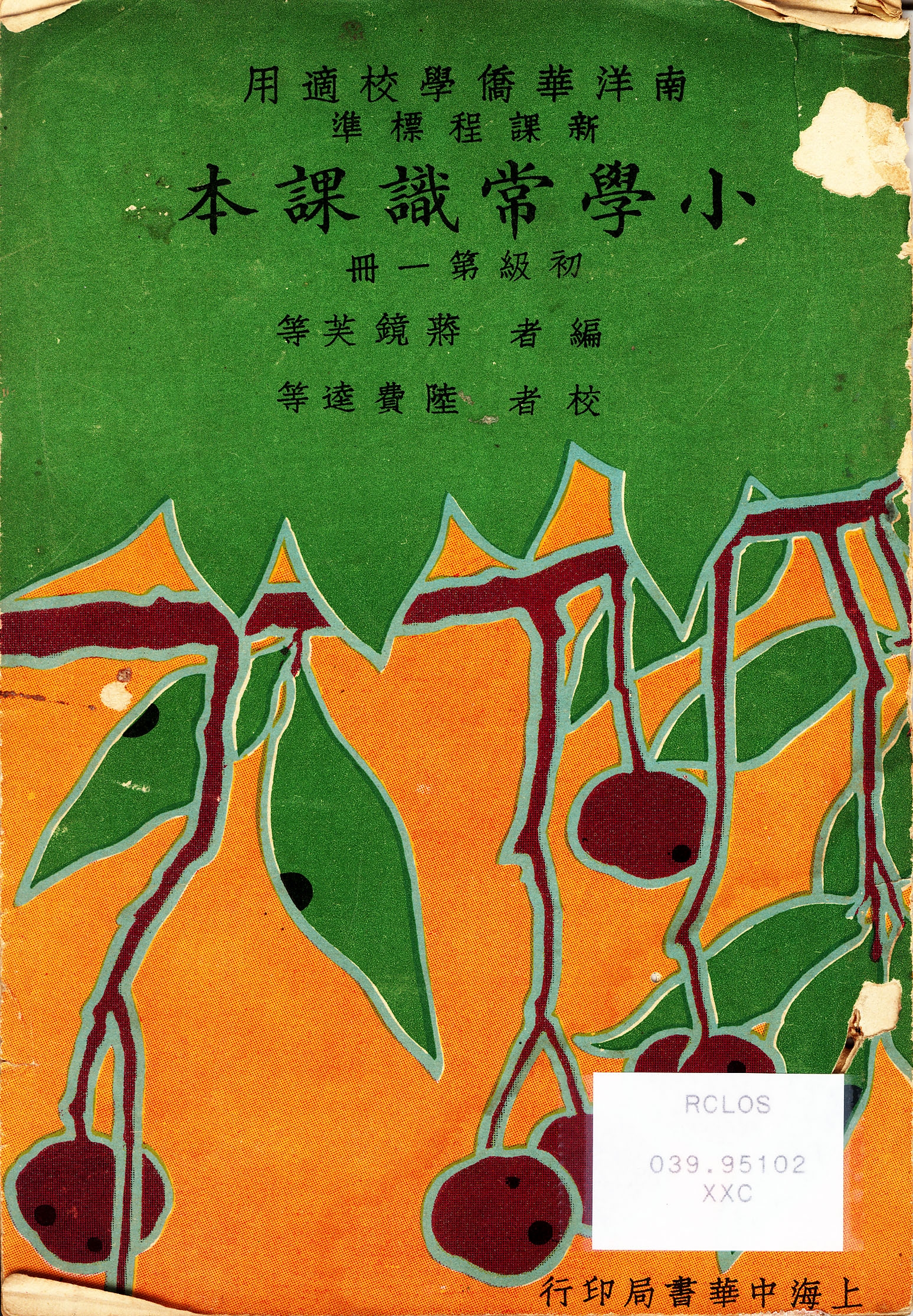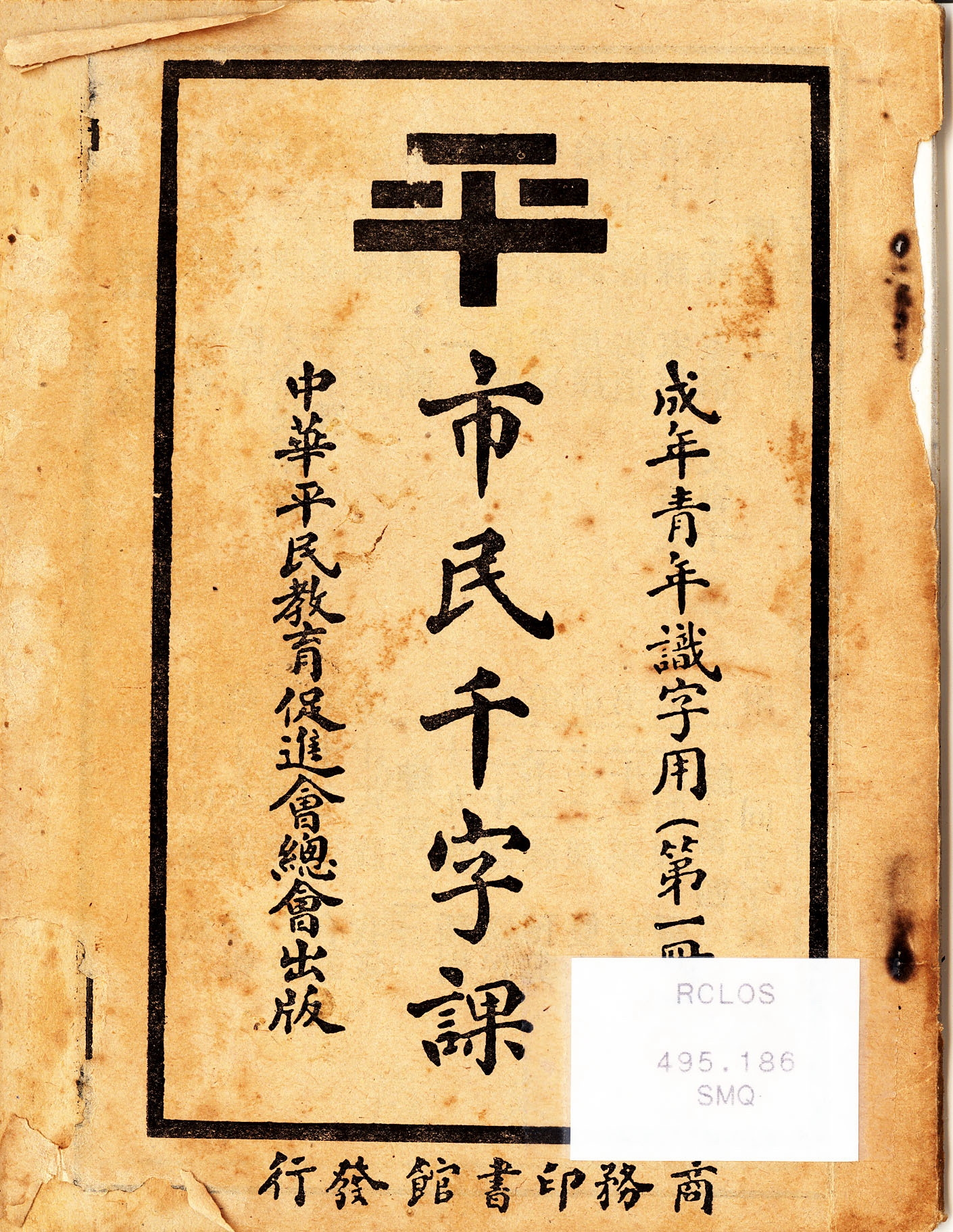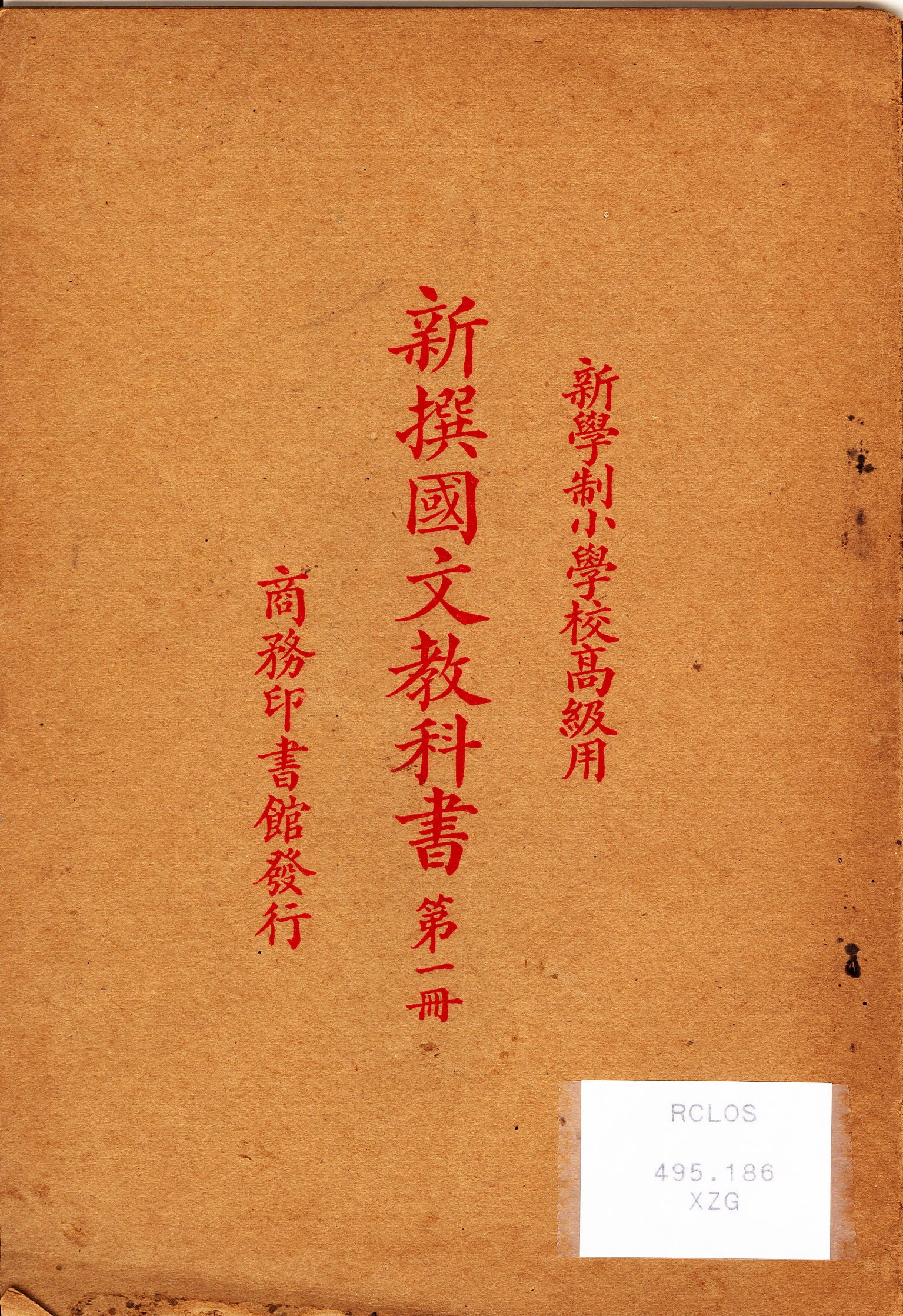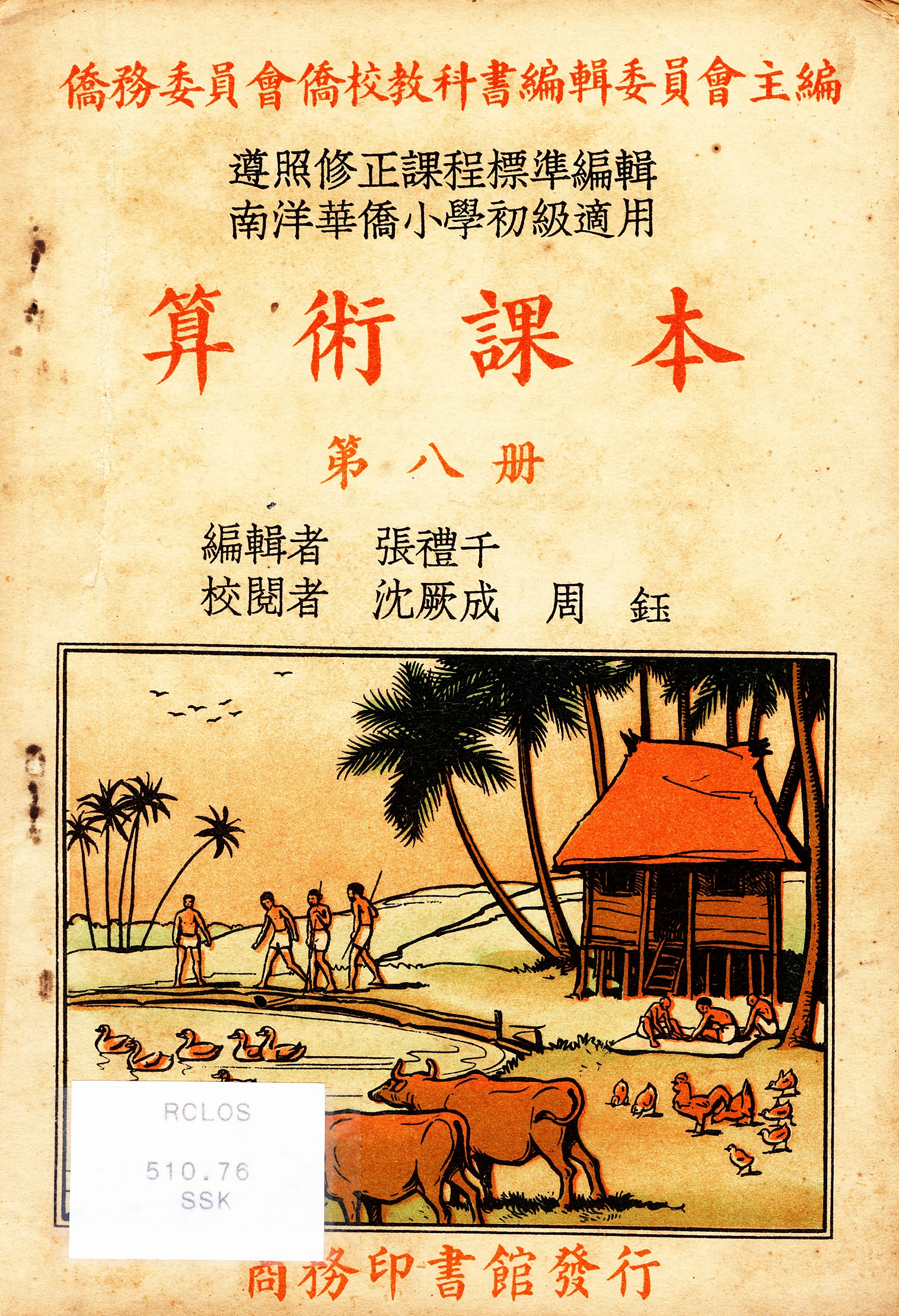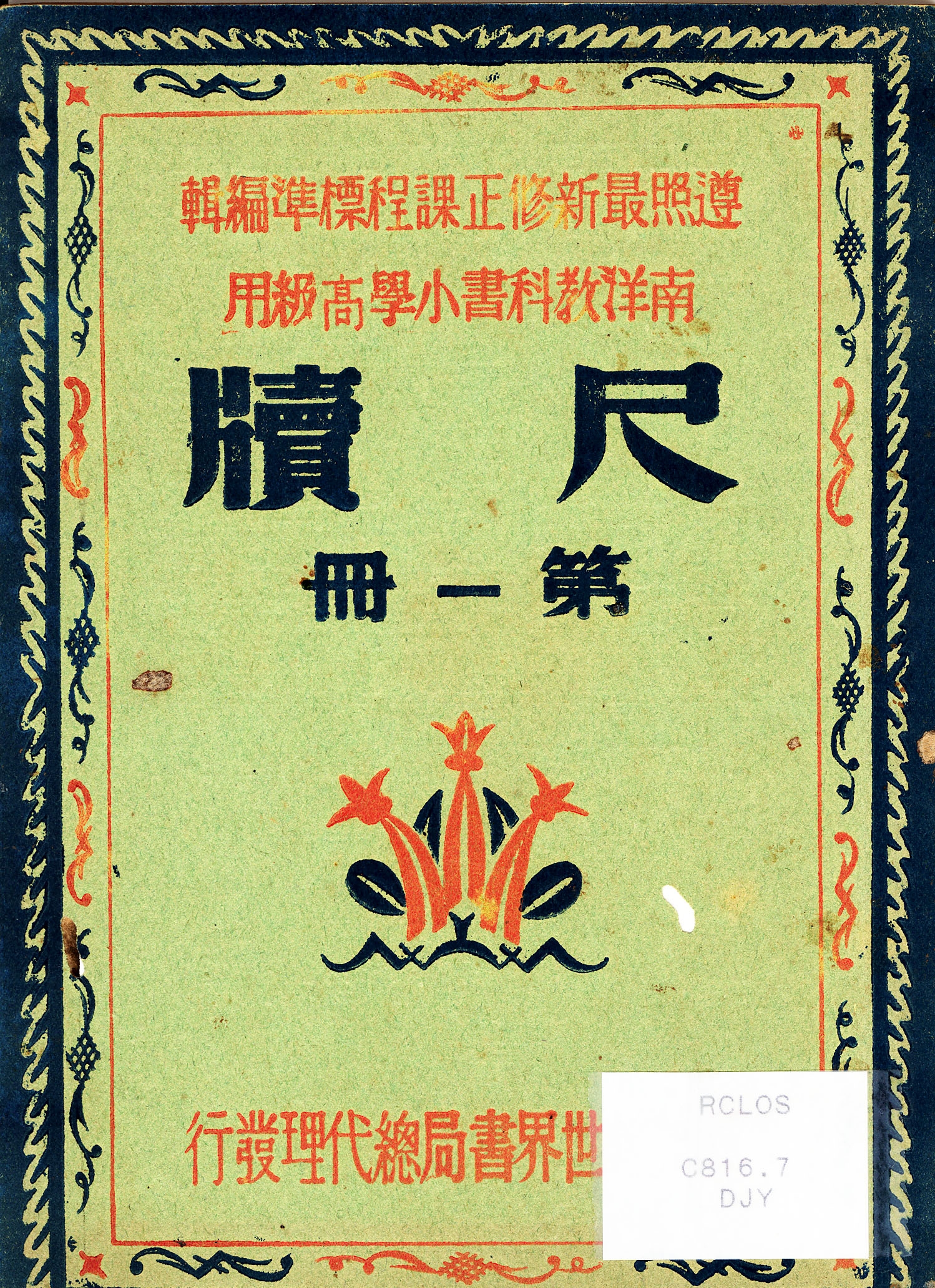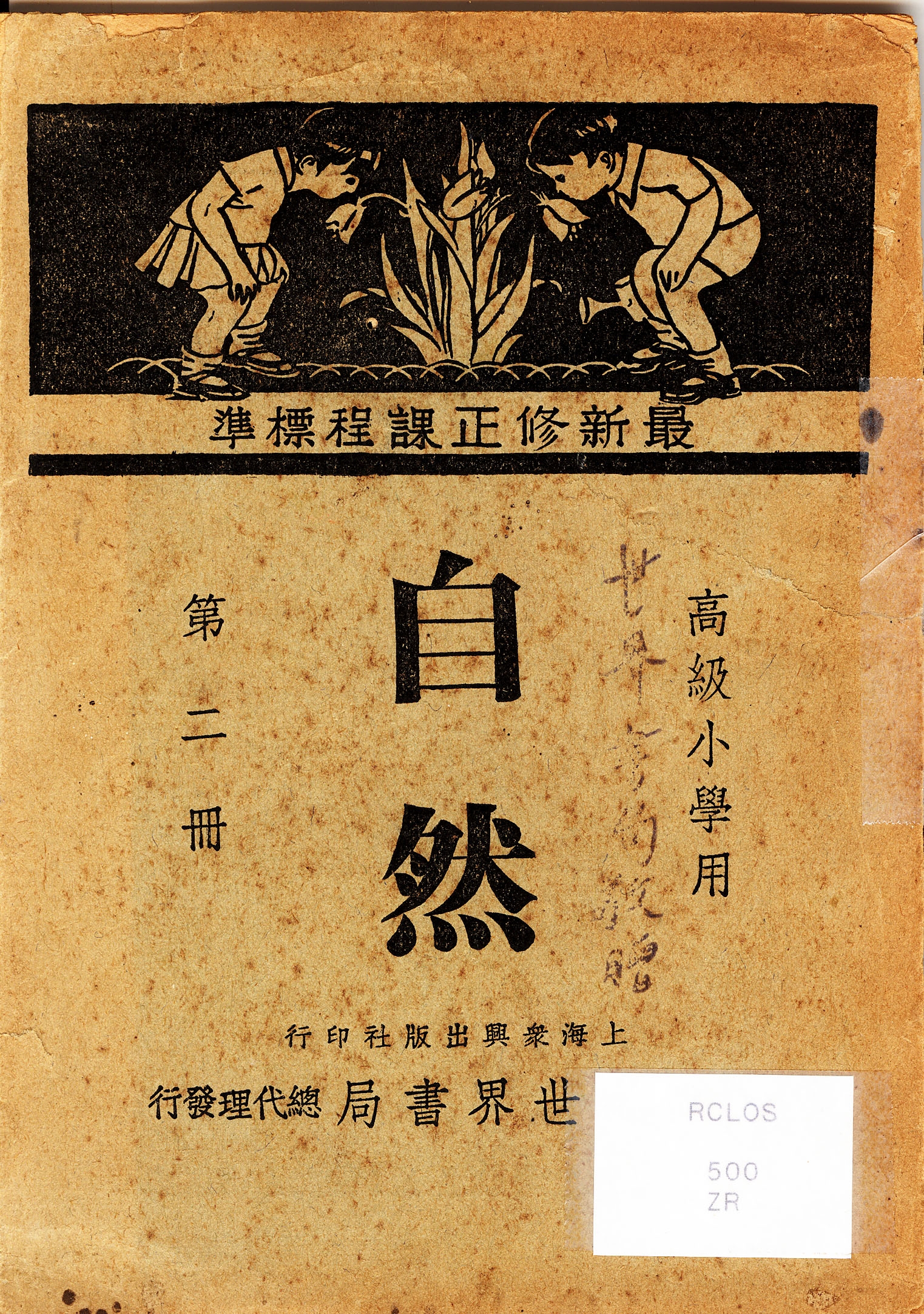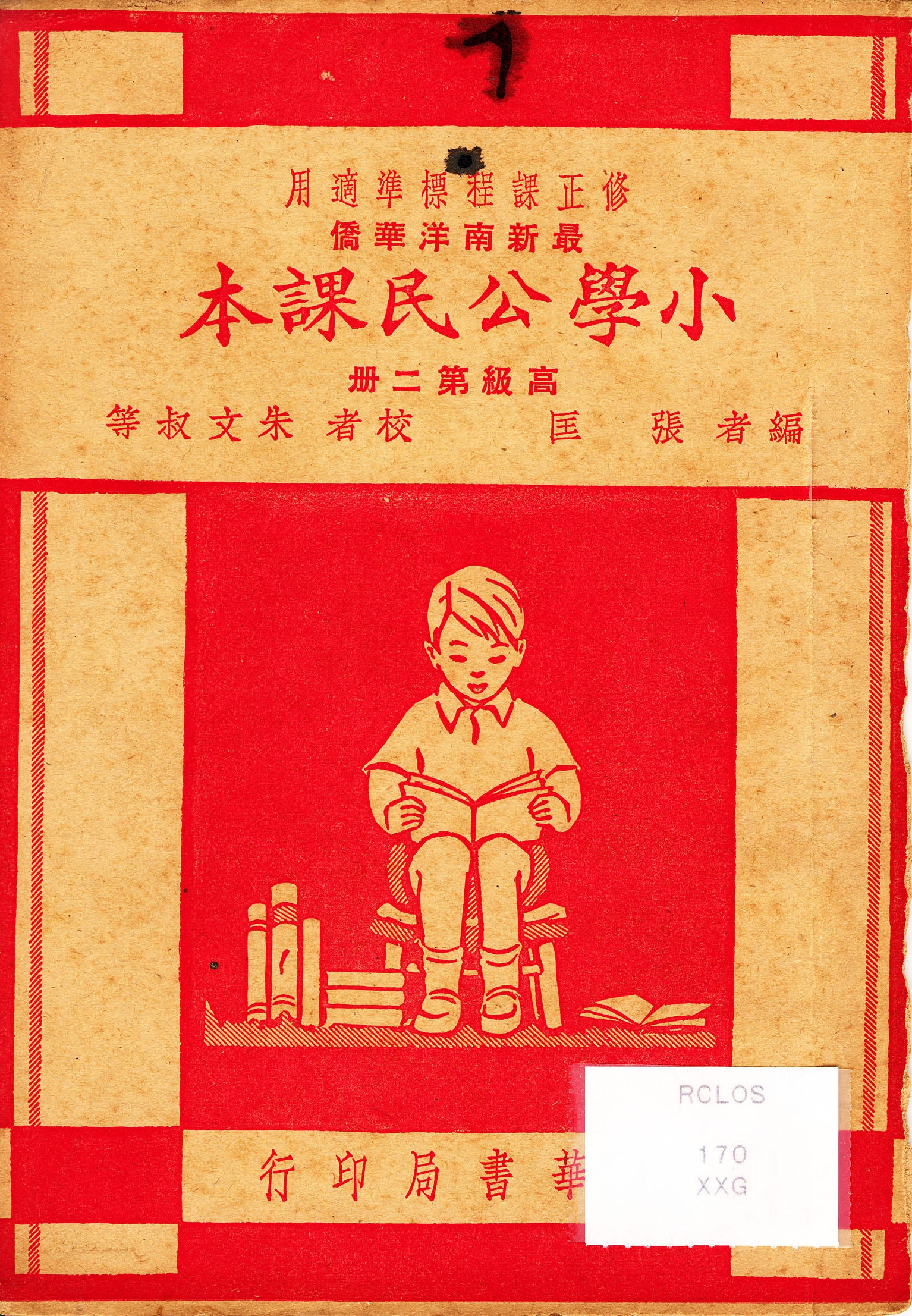A Historical Review of the Prewar Chinese Curriculum and Textbooks Used in Singapore
Studies on the education of overseas Chinese communities have often been carried out within the framework of examining the education policies and politics of China and that of the local governments. By examining other local events and factors, a more exact picture of the Chinese modern education in Singapore could be discerned.
Introduction
The Chinese society of Singapore in the 19th century was by and large, a transient community, comprising mostly Chinese immigrants from China. The majority of Chinese immigrants were males who had come to “Nanyang” in search of employment or to trade. Many of them left their families in China or eventually returned to China when they earned enough. With the lifting of the ban on general emigration by the Qing government in 1893, the number of Chinese immigrants increased significantly. Some of them brought their families along. In the year 1901 alone, 8,060 female immigrants arrived in Singapore. It was also towards this time that local Chinese births doubled from 1,076 to 2,203 between 1887 and 1900.1 This was not merely a quantitative change within the Chinese community. With the increase in the number of females and children in the community, there were also fundamental changes in the nature of the community. The newly formed family units brought about an increasing need for social institutions, including schools for their children.
The early 20th century was a time of uncertainty and great changes for China. The Qing Dynasty, in its attempt to sustain the imperial regime, instituted a series of changes, including the modernisation of China’s education system. It was during this period that China started to transform its schools. Many scholars have elucidated on how education reforms in China had shaped similar initiatives of the Chinese overseas. The matter may be more complex and one can examine the reality of the matter by taking a closer look at the actual situation in Singapore, in particular, through the curriculum and school textbooks used by the local modern vernacular schools.
At The Dawn of Modern Vernacular Chinese Education
Up till the time when modern Chinese vernacular schools were founded in the first decade of the 20th century, Chinese classical texts like the Trimetrical Classics (Sanzijing), the Hundred Families Surnames (Baijiaxing) and the Millenary Classics (Qianziwen) were known to have been used in the local Chinese schools.2 This was first noticed by Khoo Seok Wan (1874–1941), “a man of enlightened views”, according to Song Ong Siang.3 Khoo was born in China and came to Singapore with his father when he was just seven years old.4 In 1888, he returned to China to prepare for the Imperial Examinations. Six years later, he took part in the Imperial Examinations and was awarded the title of Ju Ren. Though educated in the Chinese classics, Song Ong Siang also described Khoo as “a man … strongly in sympathy with the revolutionary movement in China”.5
Evidence of this “strong sympathy” was his involvement in the founding of the Singapore Chinese Girls’ Schools in 1899. He donated $3,000 towards the establishment of this school of the Straits Chinese, an act which Song felt was “worthy [of] more than [just] a passing mention, for at that time”,6 the leading Straits Chinese were “apathetic, if not inimical, to the cause of female education and refused to contribute anything”.7 Khoo did not just contribute financially to such education efforts. He spearheaded early syllabus reforms too. Khoo had noticed that classical texts, such as the Millenary Classics (Qianziwen), used in many old-style private teaching (si shu) at that time, were too difficult for young students. He found that too many obscure words were used in the Millenary Classics and students who studied it for many years ended up still not being able to write their own names, compose simple letters or grasp the rudiments of the Chinese language. Hence, he concluded that if the teachers clung on to tradition and persisted in using these textbooks, it would ultimately be detrimental to the students.8
In 1902, Khoo selected 479 characters from the original text and added another 521 more commonly used words to form a new Millenary Classics (Xin Chu Qiziwen). As Khoo was a talented poet, he put this poetic flair to good use when he put these 1,000 characters into 52 sentences, each with four characters. The sentences were grouped into eight chapters. The topics in these chapters ranged from teaching students how to recognise items from every day life and at the same time, instilling values in them.9 This new Millenary Classics is the earliest known existing textbook produced locally for elementary education in Singapore.10
As the winds of modernisation garnered greater momentum at the turn of the 20th century, the major Chinese dialectal communities founded several modern Chinese schools in Singapore. The Cantonese founded the Yeung Ching School (Yangzheng Xuetang) in 1905. The next year, the Hakkas set up Yingxin School and Khee Fatt School (Qifa Xuetang).11 In 1906, the Toh Lam School (Daonan Xuetang) and the Tuan Mong School (Duan Meng Xuetang) were founded by the Hokkiens and the Teochews respectively.12 As for the Hainanese, they too started a modern school, Yoke Eng School (Yu Ying Xuetang), for their children in 1910.13
Although the syllabi and teaching styles of these schools have not been thoroughly documented, it is certain that they were not old-style schools (si shu). It was during this time that the 1911 Revolution in China also resulted in fundamental change in the socio-political culture for China. This new phrase of China’s journey towards modernity affected all Chinese, including those abroad. For the Chinese overseas, it was through their institutions like schools that the trappings of modernity first took root. The Hokkien merchants of Singapore were among the first to push for change. They advocated revising and bringing up-to-date the teaching at Toh Lam School and other old-style schools, according to the “new rules and regulations of the Chinese Ministry of Education”.14 This is one of the first examples of how the Chinese in Singapore attempted to follow China’s education model. Eventually, the resultant form of vernacular Chinese education in Singapore also included the considerations of socio-political and economic realities of early 20th century Singapore. Even when they acquired textbooks from China, the China printers normally had a “Nanyang” edition of their publications that incorporated local “needs” and “conditions”.15 China also recognised this difference and even set up special colleges such as the Jinan Da Xue (Chi-Nan University) to train teachers specifically for Chinese schools in Nanyang.16
The Colonial Government and Textbooks for Local Needs
After 1911, most of the colonial governments in Southeast Asia grew apprehensive of the political influences from China. In the Straits Settlements, the Colonial authorities passed the School Registration Ordinance of 1920. It heralded British direct involvement with the education of all children in Singapore. They were concerned no longer just with the English-stream schools and Malay vernacular schools.
With this Ordinance, the local government sought to “gain control over all schools in the Colony”. The government officially declared three points:
Firstly, that the schools shall be properly conducted as schools; secondly, that the teachers in them have efficient training for teaching, and thirdly, that the teaching shall not be of such a kind that is against the interest of the Government of the Colony.17
Under this Ordinance, both the managers and teachers of all schools were required to register with the Education Department within three months, for existing schools, and one month for new schools. In addition, any changes in the teaching staff or committee of management of the registered schools had to be reported to the Education Department within one month. Every registered school was also to be opened to inspections by the Director of Education and he was empowered to declare schools unlawful if the schools, the teachers or the managers were found to be involved in political propaganda detrimental (or prejudicial) to the interests of the Colony.18
To ensure that the objectives of the Ordinance were met, the Ordinance and the General Regulations were repeatedly amended to make them more effective. The first amendment to the Ordinance was made in 1925 and it was amended again in the following year to make it even more stringent. The General Regulations were also revised for the same purpose.19 In addition to legislation, the Straits Settlements Education Department also started writing textbooks for use in the Chinese schools in the 1920s.
In 1923, the British Education Department explored the possibility of compiling textbooks locally, which would be suited to local needs.20 The preparation of the books was slightly delayed, but by 1925, it was reported that “primary school readers and text-books on hygiene and geography with appropriate reference to local conditions” were in the course of preparation.21 This task was continued for another two years until 1927, when “a series of readers for Chinese Schools was nearly completed and arrangements to have them printed were under discussion at the close of the year.” When the compilation of a geography reader was nearing completion, there were plans to compile other manuals on arithmetic and hygiene.22 Approval was soon given for the publication of a trial edition of these locally written Readers by a local firm in 1928.23 However, it appears that these textbooks were hardly used in the Chinese vernacular schools. From 1929 onwards, the Straits Settlements Annual Reports reported, “practically all the text-books used in Chinese schools are published and printed in Shanghai”.24
Survey of Modern Chinese Textbooks Used in Local Schools
The Chinese textbooks that were used in these modern schools in Singapore covered a wide range of subjects. Students were taught Chinese (Guo Wen Guo Yu), English (Ying Yu ፞J), Letter-writing (Chi Du), Mathematics (Suan Shu), Abacus (Zhu Suan), Geography (Di Li), History (Li Shi), Science (Ke Xue), General Knowledge (Chang Shi), Nature Study (Zi Ran), Hygiene (Wei Sheng), Moral Education (Gong Min), Arts (Mei Shu), Music (Yin Yue) and Sports Education (Ti Yu). The range of subjects instructed in each school varied, depending on the resources of individual schools. Nevertheless, from the textbooks that survived till today, we could see that the schools of that period provided their students with a modern education, one that differed greatly from the old-style private teaching where the students recited the lines of the Confucian classics after their teachers and committed these texts to memory.
An examination of the textbooks on these subjects showed that they broke away from the traditional curricula (ie. the Confucian classics) and were similar to the Western tradition of education. Learning took place on a progressive path. In the case of languages, students were introduced to basic words when they first enrolled in schools and were exposed to a larger corpus of words as they advanced. We could see this in both the Chinese and English language textbooks. Students at the elementary levels were first taught individual words or phrases and as they moved up, their language lessons comprised sentences and paragraphs.25 Likewise for subjects like Mathematics, simple concepts such as counting, addition and subtraction were taught before the students learned about multiplication and division. For the students in higher levels, they were introduced to specialised branches of mathematics such as Algebra, Geometry and Trigonometry.26 A similar approach was also applied to subjects like History and Geography.27
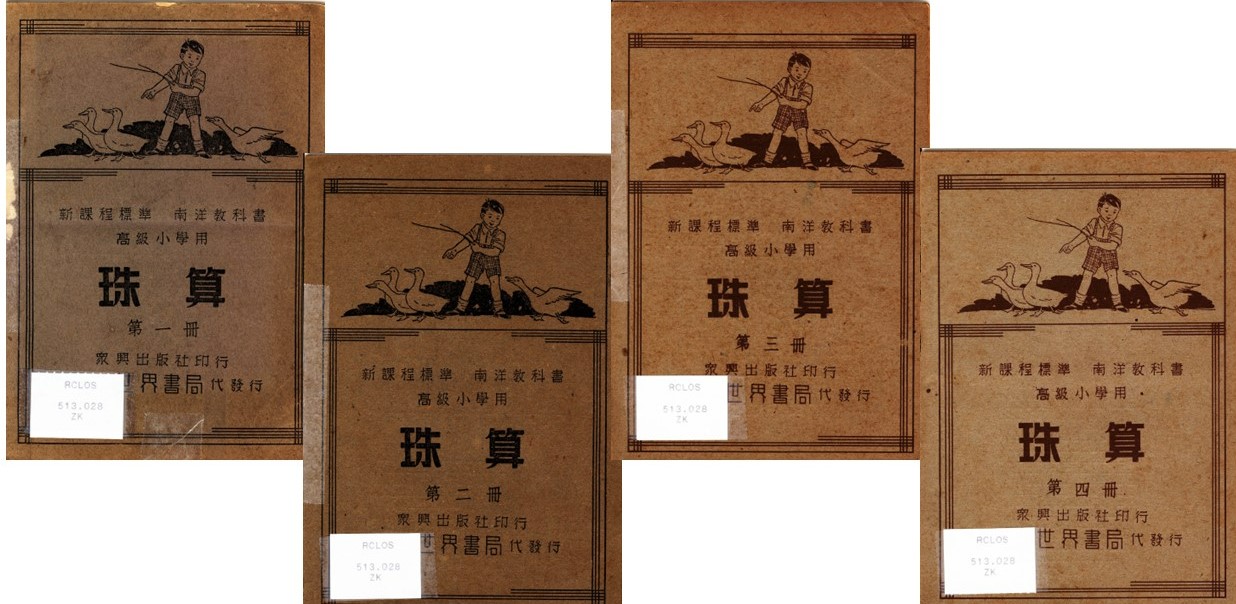
Besides the subjects above, practical subjects that helped the students secure jobs after they graduated were also taught. There were textbooks on Abacus and Letter-writing. Equipped with the knowledge of how to use the abacus, students could work as book keeping clerks in shops and even within English establishments. Letter-writing lessons showed the students how to draft simple correspondences should their future work require so.28
Students were also inculcated with general knowledge about the world they lived in. General Knowledge, Nature Study and Hygiene textbooks explained the changes in housing as human beings evolved (from the caves to the trees and eventually houses), parts of a plant and how they pollinate, organs of a modern government (parliament, constitutions, courts, etc), various types of transportation, personal hygiene to prevent the spreading of germs and many other issues.29
Besides the textbooks above, there were also textbooks that instilled values to mould and shape one’s character. Moral Education, Art and Music were taught in schools too.30 In Moral Education, values that were perpetuated in the Confucian texts such as respect to the elders, good behaviour, cherish public property, care for another person and other similar subject matters were taught. Art and music lessons were held to teach students how to appreciate fine arts and music. Students also learned teamwork and keeping good health through sports.
While it appears that the modern Chinese education before 1941 had retained certain cultural and moral values of the old tradition, by and large, from the curriculum and textbooks used in the schools, we can deduce that Chinese education in Singapore had evolved into a modern form. Besides the influences from the changes and practices in China and in the English schools, some Chinese in Singapore had also taken the lead themselves, just as Khoo had shown the way.
Conclusion: Sources and Location
Studies on the education of the Chinese communities overseas have often been carried out within the framework of examining education policies and politics of China and that of the local governments. By examining other local events and factors, a more exact picture of the Chinese modern education in Singapore could be mapped out.
Firstly, from the efforts of Khoo, we can see that Chinese education in Singapore did not entirely follow China’s lead. Besides Khoo, there were many like-minded individuals who played an active role in setting up schools for the Chinese community in Singapore. These school founders were propelled by the need to educate their youngsters and it was this need that drove them to chart out an education that was best suited to the environment here. They had to ensure that the curriculum taught were not just propagation of tradition values but included practical skills and modern values, which would equip the students adequately to face the challenges of the “modern world”.
Currently in Singapore, besides private individuals, several institutions are known to have collections of these textbooks used before 1941. These institutions include: the National University of Singapore Chinese Library, Singapore History Museum, Chinese Heritage Centre, Singapore Federation of Chinese Clans Associations and the Lee Kong Chian Reference Library of the National Library, Singapore.
Due to the antiquarian nature of these books, they are generally not available to the public. Nevertheless, these institutions have opened their collection to the public in other ways. For example, in 2003, when the Chinese Heritage Centre received a donation of Chinese-school textbooks, periodicals, school magazines and school publications published between 1912 and 1960s, from an Indonesia-Chinese, Professor Eddy Hermawan,31 the Centre organised an exhibition titled “Grooming Future Generations Through Education: Chinese-School Textbooks in Singapore, Malaysia and Indonesia before 1965”, in 2003. Items from the National Library’s collection and private individuals were also showcased at the exhibition.
Since the opening of the Lee Kong Chian Reference Library at Victoria
Street in 2005, the Library has received numerous donations, including
several hundreds volumes of textbooks. A selection of these textbooks will
be displayed at the National Library’s newly created Donors Gallery in
appreciation of the generous donations from the various individuals. Opening
in November 2007, the Gallery is located at Level 10 of the National Library.
These donated materials are available for consultation upon request at
the Information Counter located at Level 11. Library patrons may search
the textbook collection through the Library’s online catalogue at https://www.nlb.gov.sg/main/home using
keywords, such as title or subject.
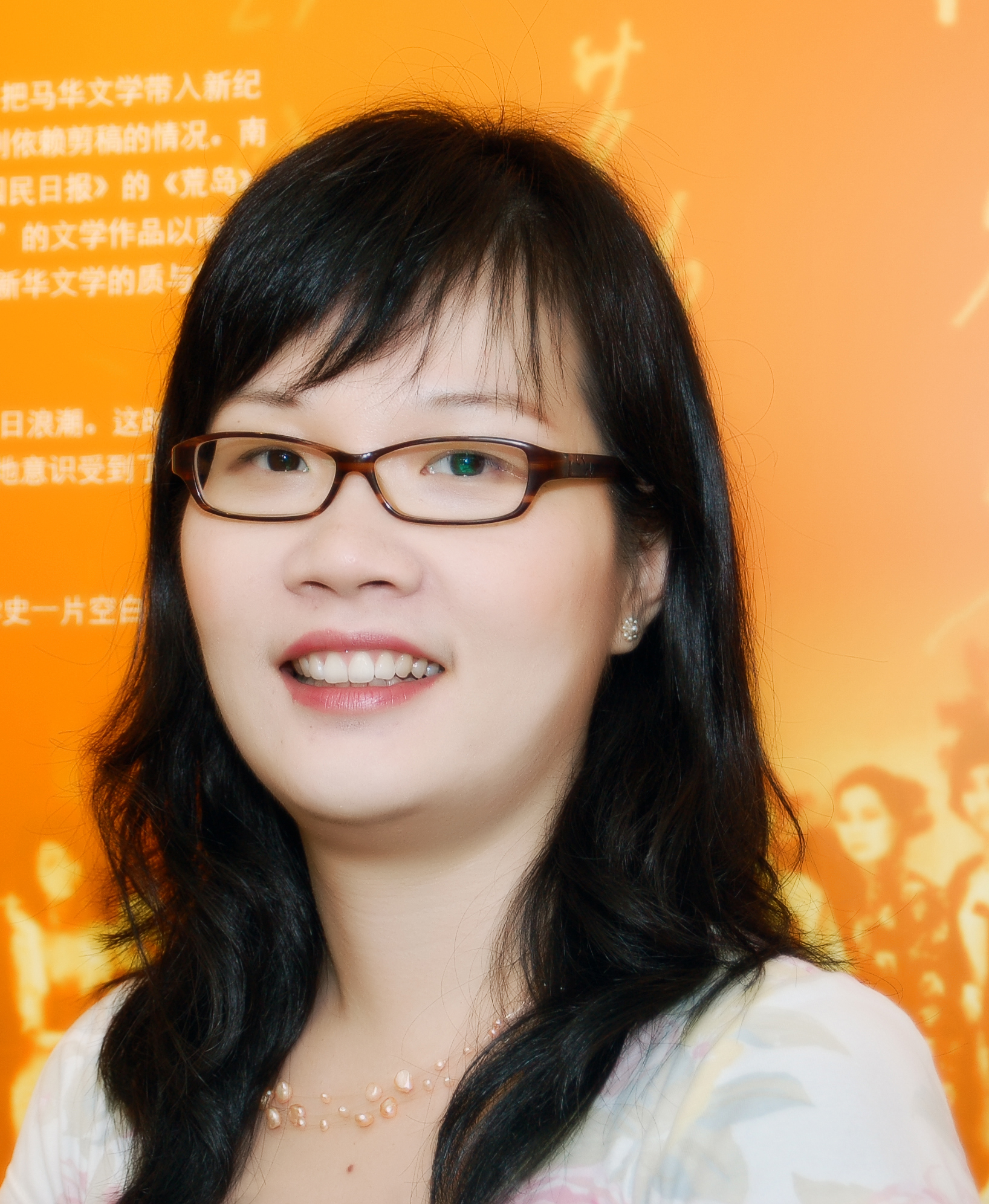 Wee Tong Bao
Wee Tong Bao
Reference Librarian
Lee Kong Chian Reference Library
National Library
NOTES
-
Straits Settlements, Annual Report 1887 (Singapore: Government Printing Office, 1887), 2 (Microfilm NL619); Straits Settlements, Annual Report 1900(Singapore: Government Printing Office, 1900), 82. (Microfilm NL1132) ↩
-
Lee, Ting Hui, Chinese Schools in British Malaya: Policies and Politics (Singapore: South Seas Society, 2006), 3 (Call no. RSING 371.82995105951 LEE); Xu Suwu 许苏吾, Xinjiapo hua qiao jiao yu quan mao 新加坡华侨教育全貌 [Overview of overseas chinese education in Singapore] (Xinjiapo 新加坡: [Zhu zhe] [著者], 1950), p. 14. (Call no. Chinese RCLOS 370.95957 HSW) ↩
-
Song Ong Siang, One Hundred Years’ History of the Chinese in Singapore (Singapore: Oxford University Press, 1984), 101. (Call no. RSING 959.57 SON) ↩
-
Ke Mulin 柯木林, Xin hua li shi ren wu lie zhuan 新华历史人物列传 [Who’s Who in the Singapore Chinese Community] (Xinjiapo 新加坡: Jiao yu chu ban gong si, 教育出版公司, 1995), 102–3. (Call no. Chinese RSING 959.570092 WHO) ↩
-
Song, One Hundred Years’ History of the Chinese, 101. ↩
-
Song, One Hundred Years’ History of the Chinese, 101. ↩
-
Song, One Hundred Years’ History of the Chinese, 101. ↩
-
Yeo Mang Thong 姚梦桐, 邱锡云和“钱子文”(“Khoo Seok Wan and ‘Qian Zi Wen’ ”), 亚__洲文化 Asian Culture no. 8 (1986): 57. ↩
-
Yeo, 邱锡云和 “钱子文”, 58 ↩
-
Yeo, 邱锡云和 “钱子文”, 56. Khoo has another earlier work: “Qian Zi Wen”, purportedly published in 1899, has not been sighted. ↩
-
Yingxin School Souvenir Magazine, 1938, 5–8. ↩
-
“Issues Discussed at the Meeting held at Thian Hock Temple” Lat Pau, 17 December 1906, 3, 10E࣡; School History” Tuan Mong School’s 25th Anniversary, 1. ↩
-
Yoke Eng School’s Souvenir Magazine, 43–44. ↩
-
“An Important Meeting of the Hokkien Merchants, Lat Pau, 17 December 1906, 3, 10; “Announcement of the Decisions Made at the Meeting Held at Thian Hock Temple” Lat Pau, 26 December 1906, 3; Song, One Hundred Years’ History of the Chinese, 407–9. ↩
-
LKCRL collection: Elementary General Knowledge Suitable for Nanyang Chinese Schools, 1935; The Latest Moral Education Textbook for the Nanyang Chinese Primary Schools, 1941. ↩
-
Jinan University 80th Anniversary Souvenir Magazine, 1988, 44–45. ↩
-
Straits Settlements Legislative Council Proceedings, 31 May 1921. ↩
-
Straits Settlements Government Gazettes, 29 October 1920, no. 21, sections 10, 11, 18, 19. ↩
-
Straits Settlements Government Gazettes, 11 September 1925, no. 15; Straits Settlements Government Gazettes, 28 May 1926, no. 5; Straits Settlements Government Gazettes, 4 January 1929, no. 4; Straits Settlements Government Gazettes, 22 January 1932, no. 132; Straits Settlements Government Gazettes, 14 May 1937, no. 40; Straits Settlements Government Gazettes, 7 January 1938, no. 40; Straits Settlements Government Gazettes, 20 May 1938, no. 1949. ↩
-
Straits Settlements, Annual Report 1923 (Singapore: Government Printing Office, 1923), 121. (Microfilm NL394) ↩
-
Straits Settlements, Annual Report 1925 (Singapore: Government Printing Office, 1925), 225. (Microfilm NL621) ↩
-
Straits Settlements, Annual Report 1927 (Singapore: Government Printing Office, 1927), 176. (Microfilm NL396) ↩
-
Straits Settlements, Annual Report 1928 (Singapore: Government Printing Office, 1928), 240. (Microfilm NL396) ↩
-
For example, in the Straits Settlements, Annual Report 1929 (Singapore: Government Printing Office, 1929), 910 (Microfilm NL397); Straits Settlements, Annual Report 1930 (Singapore: Government Printing Office, 1930), 745 (Microfilm NL397); Straits Settlements, Annual Report 1931(Singapore: Government Printing Office, 1931), 822. (Microfilm NL2921) ↩
-
Example of English and Chinese language readers are: Lim Chong Hsin, My Book of ABC, 1930; New Chinese Language Textbooks, vol. 2, 1924. (LKCRL collection). ↩
-
LKCRL collection: Arithmetic Textbook for Nanyang Chinese Primary Schools, vol 1, 1930; Arithmetic Textbook for Nanyang Chinese Primary Schools, vol. 8, 1941. ↩
-
Examples of History textbooks are: History Textbooks for Nanyang Upper Primary Schools, vols. 1 and 4. Examples of Geography textbooks are: Geography Textbooks for Nanyang Upper Primary Schools, vols. 1 and 4, 1941. Note: The last two Geography textbooks are from the Singapore History Museum. ↩
-
Some examples of Abacus and Letter-writing textbooks in the LKCRL collections are: Abacus for Upper-primary Schools, vols. 1–4, 1938; Annotated Letter-writing for Students, part 1, 1919; Letter-writing for Lower-primary Nanyang Schools, vols. 7 and 8, 1941; Letter-writing for Upper -primary Nanyang Schools, vols. 1 and 2, 1941. ↩
-
LKCRL collection: General Knowledge Textbook for Nanyang Chinese Primary Schools, vol. 5, 1935; Nature Study for Upper-primary Schools, vol. 2, 1939; Hygiene Textbook for Kindergarten, 19uu, 1937. ↩
-
LKCRL collection: Standard Moral Education Textbook for Malayan Chinese Primary Schools, vol. 2, 19–; Beautiful Songs, vols. 1–6, 1935. Private collection: Extra-curricular Sports: Track and Field, 1936. ↩
-
Chinese Heritage Centre Bulletin, no. 2 (September 2003), 44–43. ↩


